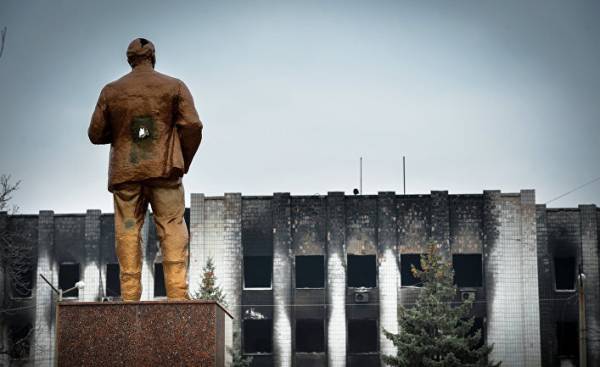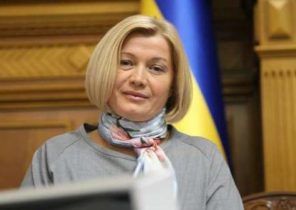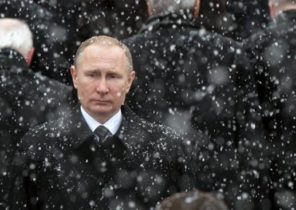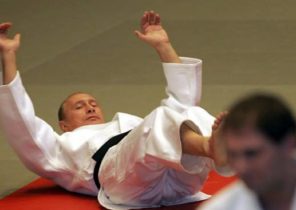
The most famous symbolic statue of Lenin in Ukraine was standing on the Bessarabia square in Kiev. This statue in the purest style of Soviet realism, which is carved from red quartzite sculptor Sergey Merkurov was given to Stalin as a gift to the city in 1946. She survived the collapse of the Soviet Union in 1991 and the “orange revolution” in 2004.
However, in December 2013 she fell. During the uprising against the authoritarian regime of Viktor Yanukovych on the Maidan a group of activists of the nationalist party “Freedom” to reset the monument and began stabbing it with sledgehammers and crowbars. “There was something spectacular and symbolic, that reminded me of the fall of the Berlin wall, says watching the scene photographer Nils Ackermann (Niels Ackermann). — People have been beating hard, as if he wanted to destroy along with the statue all the memories of the past. As a voodoo doll”.
Demolition of the Lenin monument
In 2014 and 2015 for the whole Ukraine was “Leninabad”, first natural, and then in a formal way: the law on “decommunisation” decided to get rid of all the symbols and monuments of the Soviet past (and therefore, hated in present Russia).
Familiar with Ukraine photographer Niels Ackermann and journalist sébastien Gobert (Sébastien Gobert) were impressed with the scale of the demolition and decided to trace the fate of falling from their pedestals of statues. In this painstaking work, they traveled all over the country after careful search materials in Internet and press, as well as negotiations with local authorities. “The country was 5.5 thousand monuments to Lenin, she was in the lead on their number per square kilometer, says sébastien Gobert. — Ukraine has always been obstinate, and the statue became a way to leave an imprint of Soviet ideology in landscapes and minds.”
The view from afar
The Ackerman and Gobert managed to find 70 monuments which they wrote the book “In search of Lenin” (Lenin Looking for). While the journalist collecting stories of eyewitnesses, the photographer picked up the camera angle so that it did not hit any one person. In the picture was supposed to be just a dump or a peaceful garden, gutter or the rack… Some of the monuments lying face down on the ground, were damaged or broken, painted in the colors of the Ukrainian flag or converted into Darth Vader…
 © Lugansk regional administrativement Lenin was turned into a monument to Taras Shevchenko in Luhansk region
© Lugansk regional administrativement Lenin was turned into a monument to Taras Shevchenko in Luhansk region
“At first we were afraid that everything will repeat, but then I noticed that each monument tells its own story, says Nils Ackermann. We tried to make our work as more intense in artistic terms, while remaining within the framework of journalism. No one not touched anything, we don’t give people anything to move”.
Although the style of the monuments themselves striking in their uniformity (an important element of Soviet sculptures), the fate of defeated characters gives the photos an amazing variability. Scenes may look melancholic, funny, ridiculous, nostalgic… Many images laced with humor. So, some of them, Lenin made-up, in Pierrot or dressed in Cossack, hero of the struggle for freedom and independence.
“Ukrainians have always been a strong characteristic irony, even in the most painful situations, says Nils Ackermann. — Even when on the Maidan fired on the crowd, people are never stopped joking.” The most creative approach to the fate of the statues often show artists. Leonid Kanter collects busts of Lenin and puts them in the box, leaving them to the whims of children and the will of the elements. “Here it is possible to reflect on the fate of the Empire, which always absorbs nature” — are his words in the book. In addition, the project sheds light on the remaining monuments of emptiness and lack of ideology, which could come in to replace them.
“The authorities in advance not figured out what to do with them, what to put instead of them,” notes sébastien Gobert. Replacement is not always on top.
Thus, in Sumy there was a statue similar to the Olympic champion Vladimir Golubnichiy, this is not to say that it flattered the original… Some authorities have asked the opinion of the residents. Whatever it was associated with the cult of personality the habits just do not to eradicate: in New Bogdanovka instead of a monument there was a fountain, only here we call him the fountain of Lenin.
“In a Carpathian town of Lenin Avenue was the prospect of Lennon,” laughs Sebastien Gobert. “This project has shed light on the limits of de-communization, he continues. — Even removing the statues, the country will not be in the blink of an eye of a globalized market economy. Still the presence of Lenin and Soviet era, in our case manifested in the bureaucracy, with which we had to deal with, and not amenable to understand the permissions that we had to… one of Lenin took almost a month!”
 © RIA Novosti, Alexey kudenko | go to fotobanka V. I. Lenin in front of city Council in Shahtersk
© RIA Novosti, Alexey kudenko | go to fotobanka V. I. Lenin in front of city Council in Shahtersk
Throughout the book, the monuments reflect the mixed feelings of the Ukrainians. Some bought them out of nostalgia for the days of childhood and the then the whole roads. The other principle I want to keep the traces of history. Still others hope to attract tourists… or they just don’t have money on tap. Those who want to get rid of them, driven by hatred of Russia, or the hope of earnings from the sale of metal. “This diversity testifies to the endless variety of opinions of Ukrainians on the past, concludes sébastien Gobert. — We wanted to highlight the nuances and complexity of the situation.”
After considerable efforts, reporters still managed to find the remains of the once standing on the Bessarabian square the majestic monument, which was broken into pieces. One small fragment appeared in the Museum of Uzhgorod, the hand was a trophy in the collection of a member of the party “Freedom”, and the maimed head is the officer of the Ukrainian army. With the help of metal legs have made her into a monstrous spider who is the guardian of his Kiev apartment.







